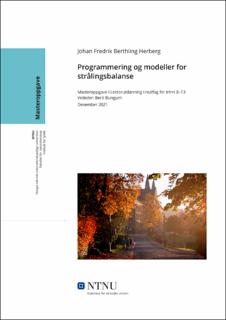| dc.contributor.advisor | Bungum, Berit | |
| dc.contributor.author | Herberg, Johan Fredrik Berthling | |
| dc.date.accessioned | 2022-02-11T18:19:41Z | |
| dc.date.available | 2022-02-11T18:19:41Z | |
| dc.date.issued | 2021 | |
| dc.identifier | no.ntnu:inspera:98193335:32524242 | |
| dc.identifier.uri | https://hdl.handle.net/11250/2978561 | |
| dc.description.abstract | Gjennom fagfornyelsen har programmering blitt innført som en ny ferdighet i fysikkundervisningen. Kompetansemålene for fysikk 1 har også blitt endret og omformulert med et fokus på å redusere mengden fagstoff i kombinasjon med bredere formuleringer. De nye læreplanene skal som følge av fagfornyelsen motivere til større grad av dybdelæring. I denne masteroppgaven vil implementeringen av programmering i fysikkundervisning i kontekst av to av ny-formulerte kompetansemål bli undersøkt. Problemstillingen for denne oppgaven er:
«Hvordan kan programmering bli implementert i en fysikkfaglig kontekst hvor elevene lærer om modeller av strålingsbalanse?»
Masteroppgaven er en kvalitativ studie, hvor et intervensjonsbasert forskningsdesign har blitt tatt utgangspunkt i for designet av oppgaven. Et undervisningsopplegg utformet for å svare på problemstillingen har blitt konstruert, utprøvd og analysert. Kognitiv belastningsteori og fysikkelevers forståelse av representasjonsformer og modeller har blitt vektlagt i både konstruksjon og analyse av undervisningsopplegget. Datagrunnlaget har blitt skapt ved utprøvning i en fysikk 1 klasse, hvor observasjon og lydopptak av både elevdiskusjoner og et gruppeintervju har blitt brukt som datainnsamlingsmetode. Undervisningsopplegget var todelt og baserte seg på et oppgavehefte elevene skulle løse i kombinasjon med utfylling av halv-ferdige pythonkoder, i tillegg til gruppediskusjon relatert til programmeringsoppgaven.
Resultatene viste at elevene opplevde undervisningsopplegget som utfordrende grunnet deres manglende kompetanse innenfor det relaterte fysikkfaglige temaet. Elevene mente at selv om de opplevde programmering som utfordrende, var denne oppgavens programmering overkommelig, men at de slet med å vite «hvilken» fysikk som skulle programmeres «hvor». Det tyder på at et økt fokus på å redusere den ytre kognitive belastningen relatert til utforming av elevoppgaver hvor programmering implementeres i en fysikkfaglig kontekst kan være viktig. Basert på elevenes innspill fra gruppediskusjonen i kombinasjon med min egen tolkning av oppgavens aktuelle kompetansemål, stiller jeg meg derimot usikker til om den nye læreplanen i fysikk legger til rette for mer tid og rom til dybdelæring. | |
| dc.description.abstract | Through «fagfornyelsen», the newest school reform in Norway, programming have been included as part of the physics education. Learning goals for the course “physics 1” in Norwegian upper secondary school, have been changed and redefined with a focus on reducing the amount of subject matter and formulating more open and general learning goals. The new curriculum is said to be better suited for teachers and students to participate in in-depth learning. In this master thesis, implementation of programming into physics education in combination with two reformulated learning goals, will be researched. This thesis problem statement is formulated as:
“How can programming be implemented into a physic educational context, where the students are engaged in learning about models of radiative equilibrium?”
This master thesis is a qualitative study, where intervention-based research design have been used as a basis. An educational teaching assignment have been developed, tested and analyzed in hope to answer the problem statement at hand. Cognitive load theory as well as students understanding of models and representations in a physical context have been used as a basis in both the development and analysis of the teaching assignment. A basis of data has been constructed by testing the teaching assignment in a “physics 1”-class in the Norwegian upper secondary school. Observation of the class in action, as well as recording both student discussion and a group interview have been used as methods of data collecting. The teaching assignment itself consisted of two parts, where the students first were tasked to complete an unfinished python code by following multiple related tasks, and then were tasked to discuss their work in groups.
The results showed that the students experienced the teaching assignment as overly challenging due to their lack of prior knowledge about the related physics theme. The students expressed how the experienced programming as challenging in general, but that this programming assignment (isolated) was manageable, but they experienced difficulties in knowing “where” to program “what” physics. This seems to indicate that an increased focus to reducing the cognitive load in the designing of an assignment that implements programming in a physics educational context would be of importance. Based on the students comments in the group interview, as well as my own interpretation of the learning goals, I’m questioning whether the curriculum really are facilitating in-depth learning. | |
| dc.language | nob | |
| dc.publisher | NTNU | |
| dc.title | Programmering og modeller for strålingsbalanse | |
| dc.type | Master thesis | |
